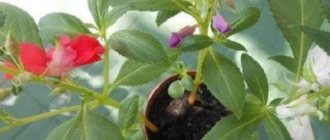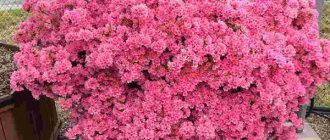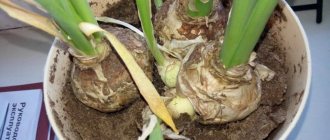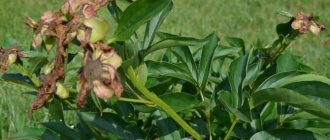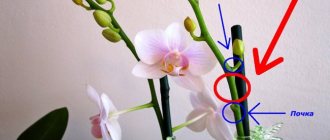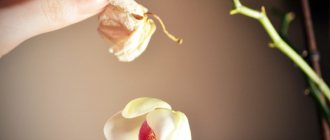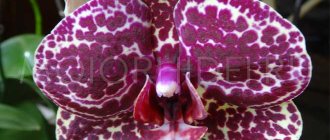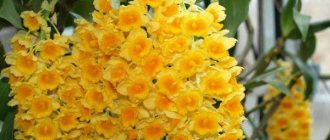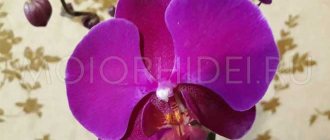Photo: Pixabay Begonia, which requires little effort to care for, is not an easy flower. Its delicate petals and thick festive inflorescences are mesmerizing, which is why gardeners grow these flowers en masse in pots and flower beds. But if initially begonia seems unpretentious, then without proper care it will cease to delight with its lush color or will dry out completely. Read the article on how to achieve abundant flowering of begonias.
What you need to know before buying Elatior begonia
This variety of begonia was cultivated in London by Z. Veitch at the end of the 19th century. The scientist crossed the Socotrans and tuberous varieties and got an excellent result: an ornamental, long-flowering plant. Elatior begonia blooms from early autumn to late winter.
Begonia Elatior - Latin name Begonia Elatior (Begonia Reniformis, Begonia X Hiemalis, Begonia Rieger) is a perennial shrub. The height of the bush usually reaches 30-40 cm, the leaf is heart-shaped with jagged edges of a rich green color, the stems are fleshy. Flowers of different colors are collected in inflorescences and can reach 8 cm in diameter. This is an indoor flower native to tropical forests. This origin determines the minimum conditions important for good growth and flowering: warmth, abundant watering and rich soil.
Begonia Elatior
Begonia Elatior has several varieties, the most common of which are:
- Borias (Borias) with soft pink flowers with a white border;
- Baladin (Baladin) with scarlet double flowers;
- Annabelle with yellow flowers. Most often used as a garden plant.
Important! Before purchasing a begonia from a flower shop, you need to carefully examine the plant. There should be no insects, cobwebs or stains on or under the leaves. They should be smooth and elastic.
Experts advise choosing plants with buds that are not fully open, since actively flowering begonia can drop its flowers if conditions change abruptly.
Photos of popular varieties
The photo shows popular varieties of “winter” flowers:
Annabelle
Borias
Elatior
Renaissance
Bellona
We will talk about other varieties and types of begonia, including ever-flowering and decorative deciduous ones, in separate articles. Read about varieties such as Brindle, Hairless, Bolivian, Mapleleaf, Diadem, Blueleaf, Metallic and Collared.
When to replant after purchase
Begonia: home care
Immediately after purchase, it is important to avoid mistakes that could even lead to the death of the plant. Begonia Elatior can be replanted after purchase only when it has completely bloomed. An emergency transplant is possible if the flower is flooded with water or the soil in the pot is of questionable quality.
In all other cases, you should think about replanting after flowering and new leaves grow. Signs of the need for replanting can also be considered roots that are cramped in the pot and begin to crawl out.
Roots
The new pot should not be much larger than the old one. It is best to buy a special soil mixture for replanting begonias in advance at a specialized store or prepare it at home. To do this, you need leaf soil (half the volume), peat and humus. You need to add a layer of sand to the bottom of the pot.
Important! If there is no special mixture for begonias, you can use soil for violets or any universal soil that contains peat.
Begonia Elatior is carefully transferred into a new pot along with a lump of earth. It is important not to damage the roots of the plant, otherwise they may begin to rot.
Varietal diversity
As you can see in the photo, begonia elatior (this flower requires special care) is a very beautiful and delicate plant. The capricious beauty requires careful treatment.
It does not tolerate significant disturbances of normal growing conditions. The varietal diversity amazes with the bright colors of the buds. There are low, medium and tall plants.
The Borias variety is very popular among gardeners. This hybrid has a compact shape. Flowers can be double or smooth. They are painted in two colors. Most often it is a light pink shade with a white edge. This plant is quite picky to care for.
Another popular variety is Baladin. The flowers are bright red, pink or white. Characterized by abundant flowering. It grows up to 30 cm in height. The flowers should not be touched with your hands. This causes them to develop unsightly brown spots. Other popular varieties include Annabelle, Azotus, Bellona, Kyoto, etc.
How to propagate Elatior begonia at home
Tuberous begonia: planting and care at home
Begonia Elatior can be propagated in four ways at home:
- cuttings;
- sheets;
- seeds;
- tubers.
Propagation by tubers is a rather complicated process, and without experience, you can destroy the entire plant.
Growing from seeds is difficult, since Elatior begonia is a hybrid, and it is impossible to collect seed material from most varieties.
Seeds cannot be collected
To use a leaf for propagation, it must be cut off from the cutting and placed in a glass of water. As soon as the roots appear, the plant should be planted in the ground.
But the most popular method of breeding Elatior begonia is cuttings.
Reproduction of begonia Elatior by cuttings
This method is the most effective and gives quick results. For cuttings, it is better to choose a period of active growing season - spring or summer. There is an opinion that cuttings rooted in summer produce low-growing bushes that do not have time to grow before flowering begins.
Cuttings
Preparing the cuttings
Required tools and materials:
- disinfected knife or pruning shears;
- root formation stimulator or heteroauxin solution.
For rooting, choose apical cuttings with a pair of leaves and buds; the required length is about 8-10 cm. The cutting must be cut from the mother plant at an angle of 45°. After drying the cut a little in the air, you should dip the cutting in a root formation stimulator or leave it overnight in the prepared solution.
Rooting
For rooting cuttings, a small transparent container, such as a plastic cup with holes to remove excess water, is best suited. A drainage layer of expanded clay is laid on the bottom. Moist vermiculite, perlite or sphagnum are suitable as soil. The prepared cutting should be buried at a slight angle by 2-3 cm, and covered with a jar on top. It is important not to forget to ventilate the plant daily and not let the soil dry out.
Ventilation
Planting seedlings
After the roots are sufficiently strong, Elatior begonia can be planted in separate pots with a diameter of about 8 cm. Soil, perlite and vermiculite in equal parts are taken as soil.
Note! To form a beautiful crown, you need to pinch the top leaf when the height of the young plant reaches 12-15 cm.
Possible problems
Elatior begonias are disease-free plants. However, troubles with the flower occur as a result of improper care. Particularly harmful to the plant is excess moisture, which leads to rotting of the root system, disruption of its functioning, and then the negative process spreads to the foliage. The leaves also begin to dry out and rot.
Gray mold thrives in such an environment. To combat this phenomenon, special solutions of fungicides are used, as well as 1% Bordeaux mixture. High humidity and a complete lack of ventilation cause the development of powdery mildew, which is characterized by a white coating on begonia leaves. If measures are not taken in time, the plant, starting with the leaves, dries out.
This type of scourge can also be dealt with using fungicides. Another disease that is dangerous for begonias is bacterial spot. The plant becomes covered with watery spots, which soon turn brown, and the inflorescences and shoots become black. To treat such a disease, the soil is treated with disinfectants.
And as a preventative measure, it is enough to treat the flower with a mixture of copper oxychloride. Pests such as aphids, whiteflies, and spider mites can cause just as many problems for begonias. The most effective means of combating them are insecticides.
As necessary, you should pick off dried flowers, loosen the soil, wipe dust from the foliage, and inspect the plant for pests. Pay more attention and care to your beautiful begonia, and in return it will delight you with delightful and unique flowering.
We invite you to learn about the variety of species and varieties of begonia. Read about begonias Mason, Griffin, Coral, Ampelnaya, Fista, Rex, Royal, Griffith, Terry, Bauer.
How to care for begonia Elatior at home
Begonia Elatior is a very delicate plant, so it is worth providing all the necessary conditions and, if possible, not exposing the flower to stress.
Lighting
Begonia Elatior
It is optimal to place Elatior begonia on windows facing east or west. This way the lighting will be sufficient, but without direct sunlight. If placement is possible only on southern windows, the plant should be covered and created partial shade. Excess sun causes flowers to become small and pale, and in double varieties the number of petals decreases. In winter, additional lighting is not needed.
Important! Begonia Elatior should not be disturbed or turned towards the light. This can cause the buds and leaves to drop.
Temperature and humidity
The suitable temperature for keeping Elatior begonia is 18-20°C. At lower temperatures, the flower stops growing and may shed its buds. If low temperatures are maintained for a long time, the plant may develop root rot. Begonia must be protected from drafts and sudden changes in conditions.
It is not recommended to spray begonia. To maintain the required humidity, it is better to place the pot on a tray filled with wet expanded clay. Leaves can be wiped from dust with a damp cloth or brush.
Watering
The main rule is that it is better to underfill than to overfill. It is recommended to wait until the earthen ball is half dry before watering the plant. If the water stagnates, the stems or roots may rot.
Watering
Top dressing
For feeding, complex fertilizers based on minerals are used, which are applied in half the amount specified in the instructions. During the period of active growth and flowering, fertilizers are applied regularly, every 10 days. If the plant is transplanted into new soil, fertilizing should be postponed for at least 2 months.
Organic fertilizers should not be used, as the nitrogen they contain makes the plant stems brittle and transparent, and the flowers less spectacular.
Note! To stimulate lush flowering, you can use fertilizers containing a lot of phosphorus and potassium.
The soil
Begonia Elatior, like all representatives of begoniaceae, is picky about the composition of the soil, so it is advisable to use only special soil mixtures. The substrate should be nutritious and coarse; deciduous soil with peat, humus and sand is best suited.
Transfer
Caring for Elatior begonia at home necessarily includes replanting. Every spring you need to replant the plant in fresh soil. It is worth making sure that the root collar is always above the surface, otherwise the flower may begin to rot.
When to prune Elatior begonia
Pruning is necessary to maintain health and form a beautiful crown of the plant. For the first time, a young plant is pruned when it reaches a length of 7 cm, thereby stimulating the growth of side shoots. It is recommended to reduce watering until fresh leaves appear.
Trimming
When the side shoots reach 10 cm, they are cut off again. The cut location should be above the bud on the outside of the stem. Further pruning is done as necessary.
Further care of the plant
When you replant an indoor begonia, it is important to know how to care for it after the “relocation” procedure. Below are general guidelines to follow.
Temperature
The most comfortable range is considered to be from 18 to 20 degrees Celsius. However, to increase the duration of flowering, it can be lowered to 14-16 degrees Celsius.
What to do with the planting after flowering? It is often viewed as a short-lived floral arrangement and discarded early.
To prolong its existence:
- After flowering ends, keep the flower at 18 degrees Celsius. Don't overwater it; moderate watering is what you need.
- When winter is over, transplant the plant into fresh soil and trim it, leaving only three or four shoots.
- During active growth, regularly feed the flower and periodically pinch it, forming a compact bush.
- The plant will bloom again soon. But don't expect flowering until autumn.
Lighting
The ideal place to place the shrub is a window sill or a place in close proximity to a bright window. If the windows are south oriented, then in the summer, refract the sun's rays using some kind of shading.
In bright sun, the plant will bloom much more abundantly than in partial shade. But you should prepare in advance for the fact that the number of inflorescences will noticeably deplete, the flowers themselves will become significantly smaller, and their color will turn pale. And if your plant has densely double inflorescences, then the size of the petals, especially the inner ones, will noticeably decrease.
You need to carefully monitor the bush under such conditions, because the risk of burns increases significantly.
Top dressing
After we were able to correctly transplant the begonia at home, it will need timely feeding. It is recommended to fertilize with mineral fertilizers no more than once a week.
Fertilizers are applied in liquid form at the root of the plant after preliminary watering. You can purchase them in a specialized store and use them according to the instructions. The Kemira Lux mineral fertilizer has proven itself to be excellent in practice.
Advice ! Organic fertilizer should not be used, it will only harm the plant. The high nitrogen content that the flower has accumulated over the summer period will not be beneficial, because the fleshy and at the same time watery stems rot very easily and quickly.”
Sources:
https://7ogorod.ru/cvety/begonia-elatior-uhod.html https://mrdachnik.com/begoniya-elatior https://sadim.guru/begonija-jelatior-vse-sekrety-peresadki/
What to do after Elatior begonia blooms
No special measures are required after the end of the flowering period; it is enough to remove the empty flower stalks. If the plant has grown greatly, you can prune and root the cut shoots. What to do next with the cutting is described above.
From the article it is clear that Elatior begonia is a wonderful flower for decorating home windowsills. However, it requires some kind of care, which consists of selecting a suitable place, timely watering and fertilizing. If you follow the rules above, the begonia will bloom for a long time, pleasing the eye of the gardener.
0 0 votes
Article rating
Peculiarities
Begonia has flowers of different sexes: there are female flowers with pistils, and male flowers with stamens. How to tell them apart:
- On the back side of the flower, female flowers have a bulge - the future seed capsule; male flowers have nothing there.
- Double flowers in the corresponding species can only be male; female flowers cannot be double. But male flowers, at the same time, can be simple.
- If you understand what pistils and stamens look like, you can simply see them. By the way, some double male flowers may have no stamens at all. It is the modified stamens that make the flower double.
Interesting fact! Removing female flowers from their very formation can significantly increase the flowering period of begonias, as well as increase its intensity. But only if you don't want to get seeds.
Plant during flowering
From the moment it awakens, the plant begins to accumulate strength and nutrients for the upcoming flowering. Buds are laid and reproductive organs are formed.
When the begonia is ready to reproduce, first the male and then the female flowers bloom. If pollination occurs, which is done by hand, then the male flowers wither, and in the female flower a fruit-box with seeds begins to ripen. This is the time of the highest activity of the plant.
At this time, a huge amount of nutrients and microelements is consumed. An accelerated metabolism requires more water, sunlight and heat.
Difficulties in growing and reasons
When growing begonias, some difficulties may arise. Eg:
- Yellowing of leaves . This may happen because the plant does not have enough light. Also, such a nuisance can occur with too much or insufficient watering.
- The tips of the leaves have turned brown . The indoor air is too dry.
- The leaves have a dull color and there is rot . The reason is excessive watering, the earth is oversaturated with moisture.
- Fall of buds . Too much watering or the air in the room is very dry.
- Leaves fall . Most likely, the plant does not have enough light, and its stems will be quite thin with a small number of leaves. If the room temperature is high, the leaves will become curled and dry. They can also begin to rot and wither when there is an excessive amount of moisture in the soil.
